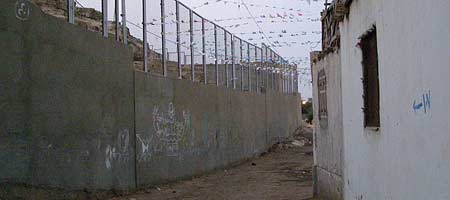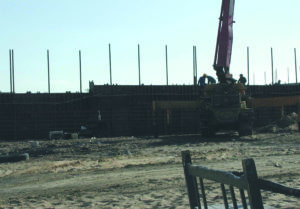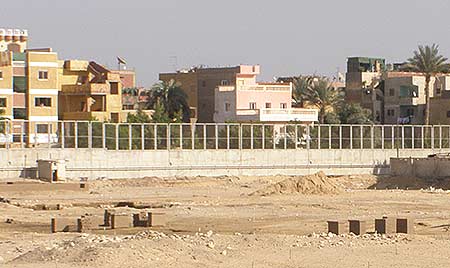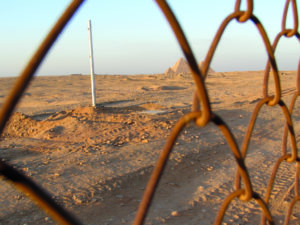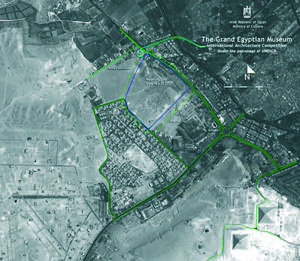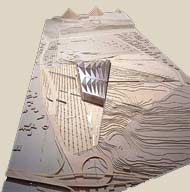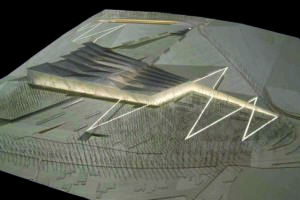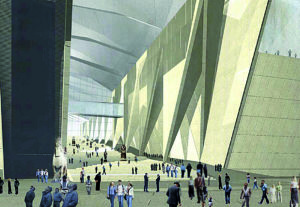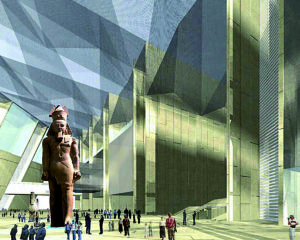The Wall around the Giza Plateau
In March 2002, we made a curious discovery while hiking up along the plateau in Giza. In the Southeastern section, far out in the desert, we came across a trench around 1.5 m / 4.9 ft wide, leading off into the distance. Puzzled, we followed it for some distance until we came upon a massive wall at the edge of the desert facing Cairo! To further investigate this construction, the next day we went to the Arab Quarter in the Northeastern section of the plateau, the direction in which the wall seemed be heading. There too, we found that a foundation trench had been dug. When we attempted to approach the ditch, two policemen appeared and warned us away with a harshly spoken, No looking! Though we were beyond the normal tourist beat, could looking at a ditch really be forbidden?
To avoid having our identities noted by the police, we immediately obeyed and acted intimidated as we left the scene. This strict guarding of the holy ditch surprised us. So, we discretely took up the trail in another location. We followed a long, narrow ditch in which further massive concrete foundations had been poured, until we came upon the wall for the first time: It was approximately 3.5 m / 11.5 ft tall and mounted on top of it were metal poles jutting up a further 3.5 m / 11.5 ft!
The sections of the wall built at that time could not be seen from the pyramids. To investigate further, we rented horses and rode out into the desert. We were able to use a zoom lens to take close-up photos of the wall around 1 kilometer / 0.6 miles behind the pyramids. Our investigations revealed that work continued on the wall both day and night. What lay behind this rapid and mysterious wall construction?
After returning to Switzerland, I learned that no one had heard that a huge concrete wall was being constructed along the far perimeter of the Giza District. Our information was new even to the renowned researcher of religion and history, Professor James Hurtak, who had also personally conducted archeological research in Egypt. He was entirely unaware of the wall construction.
The reasons for the wall
The primary explanation provided to the local population, who naturally noticed the wall construction from the start, was that the Giza District administration was taking the necessary precautions against thieves, terrorists and tourists. To offer any effective protection against thieves, however, the wall was indeed a few thousand years too late, after all, the pyramids are empty. What remains to be found that can possibly justify the building of such a massive and expensive wall? (See also the text boxes The Building of the Wall on page 226 and One Expensive wall on page 228.) Egyptologists and plateau administrators have steadfastly maintained for decades that everything has already been discovered and identified.
The Giza area is no Eldorado for thieves or souvenir hounds because it is strictly guarded and there are no cultural objects that can be easily carried off. Any loose stones from the pyramid facades are far too large and heavy to carry away. Any attempt at robbery using a vehicle was already impossible before the wall was built. Whether the wall is truly capable of offering the contemporary panacea of protection against terrorism is high questionable. It is just as possible for a terrorist to access the pyramid district as before the wall was built.
The Walls course
The building of the wall around the Giza Plateau was planned so that it would go largely unnoticed for as long as possible. The first section to be built was out in the desert, away from the city, followed by the side sections that border Cairos Arab Quarter, Nazlet-el-Samaan, separating it from the Giza District. While there had been some disquiet among the Islamic population before, when it appeared that even a section of the Arabic Cemetery would fall victim to the wall, a public outcry forced the constructors to offer a compromise. The wall was built around the cemetery, but this meant that the first row of apartments, businesses, horse and camel stalls fell victim to the construction.
Only in the final phase of construction was the wall extended from the south and north to the point of access for tourists, and even there the builders did what they could to hide it. To the east, the wall runs along the “Cheops” Pyramid*, ending approximately 100 m / 328.1 ft before the entrance. On the other side, the wall is but 200 m / 656.2 ft beyond where the bus parking is located (status as of Autumn 2004). You must leave the direct access road to see the wall. Therefore, most visitors to the pyramids will not even notice it.
Taking half a day to circumnavigate it, we measured the walls length in October 2004 with a GPS device (Global Positioning System – a satellite-guided navigation system). Horses were necessary to cover the desert stretches, while the more sensitive areas along the military zone northwest of the pyramids were crossed discretely by foot. By this method a map was made of the progress of the wall (see page 218), which will present the first published general impression of the extensive fencing in of Giza.
The Building of the Wall
In the year 2001, the Egyptians began to build a simple wall with natural stone and cement mortar around the front section of the Giza Plateau that matched the general appearance of its surroundings. We noticed this construction while visiting the summer of 2001, but took no photos. We were as yet unaware of the significance of this wall. This first wall built by the Egyptians was but a few hundred meters / feet long when construction was brought to a halt. According to trusted sources in Cairo, construction ended after an inspection was conducted by foreignors. To the astonishment of the local population, the stone wall was then torn down. It lacked a solid foundation and could have easily been tunneled under, which apparently made it insufficient for the constructors.
Towards the end of the year, backhoes and building machinery appeared in the desert and began excavating a ditch for a new foundation, which turned out to be the start of a new, massive, cement wall. This new wall was built upon a double row of steel-reinforced cement foundations poured as deep as 1.5 m / 4.9 ft into the ground. The wall itself is 0.8 to 1 m / 2.6 to 3.3 ft thick and up to 3.5 m / 11.5 ft high with prefabricated fence elements erected on top, doubling its height, making it 6 to 7 m / 23 ft tall. Construction on this scale is generally only found surrounding military facilities.
The builders
- The Egyptian Government
- SCA Supreme Council of Antiquities
On November 7, 2005, the Egyptian government published a small article about the Wall on its homepage commemorating the official completion of the wall construcion: «Pyramids plateau electronically secured by 2006: A plan to electronically secure the Pyramids Plateau, implemented over the past 3 years, will be given the go-ahead by President Hosni Mubarak early next year. The plan is a collaborative effort of the Ministry of Culture and the National Security Agency./ Minister of Culture Farouk Hosni said that the project cost LE55 million, and includes the establishment of a 15-km fence around the plateau, to protect against squatting. The fence is entirely away from the panorama of the pyramids, and does not have a negative impact on the aesthetic scenery of the Plateau./ Secretary General of the Supreme Council of Antiquities (SCA ) Dr. Zahi Hawas said that the plan provides the area with about 20 electronic gates to regulate and control visits.»
Source: www.sis.gov.eg/En/EgyptOnline/Culture/000001/0203000000000000000506.htm
The GEM (Grand Egyptian Museum)
This is an excerpt from the book GIZA LEGACY.



